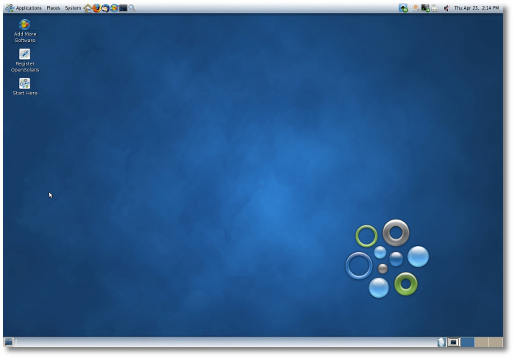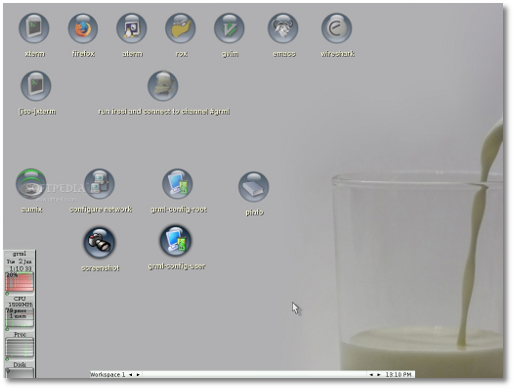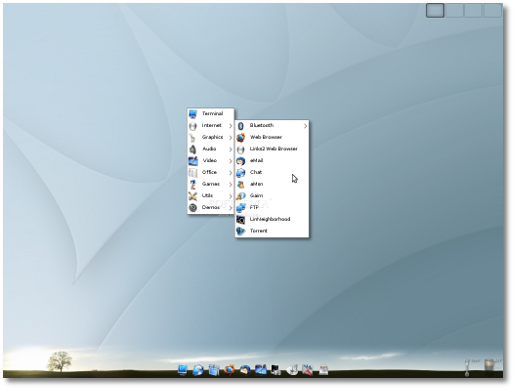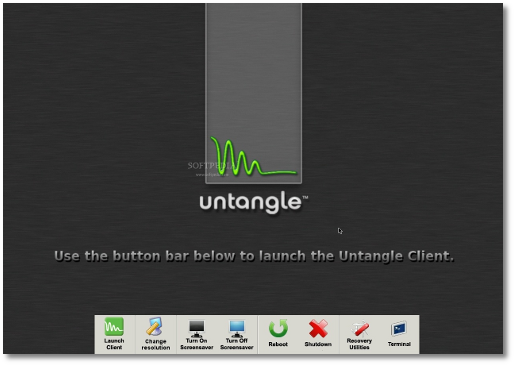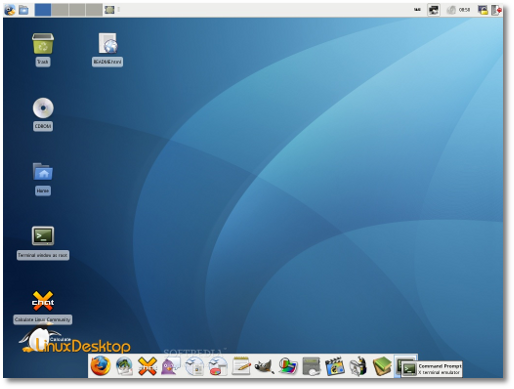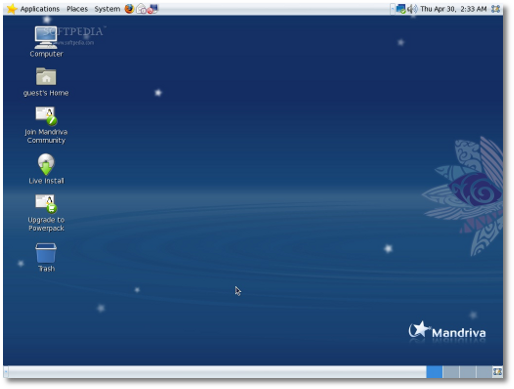Welcome to the 48th issue of Softpedia Linux Weekly!
This week's editorial talks about the upcoming NILFS filesystem for SSDs. In the distribution announcement section you will find the following releases: OpenSolaris 2009.06, grml 2009.05, Elive 1.9.28, Untangle Gateway 6.2.0 and Calculate Linux Desktop Xfce 9.6. In other news: Nvidia released a new version of its Linux Video Driver; Ubuntu Moblin Remix was announced at Computex; KDE 4.2.4 was released and it improves Okular and KMail; the first beta of Opera 10 for Linux shines; the new Amarok 2.1 brings a plethora of cool features and Google officially announced Google Chrome for Linux. As a big surprise for our readers, we've prepared a very nice review for the newly released Mandriva One 2009.1. The weekly ends with the video clip of the week, the latest Linux distributions released/updated last week and the development releases.

Summary:

 Editorial: The NILFS Filesystem - by Daniel Pop-Silaghi
Editorial: The NILFS Filesystem - by Daniel Pop-Silaghi
· Everybody seems to be talking these days about two filesystems: EXT4 and Btrfs. Though the latter still needs some time to mature, EXT4 has taken the distro world by storm. While only a few default their installations to it, all major distributions offer it as an alternative. And why wouldn't they? Tests have proven that it's a lot faster than its elder brother, EXT3.
But, as the new 2.6.30 Linux kernel approaches the release date, another file system emerges from the shadows: NILFS2 (an acronym for New Implementation of a Log-structured File System), which will most likely be supported in the upcoming kernel.
So what could make one consider switching again to yet another filesystem? Well, how about continuous snapshotting? That probably doesn't ring any bells to some of you, so here is an example: say you've accidentally and permanently deleted an important file. In other filesystems, it would've probably meant dead end, or the start of a tiring search for file-recovery software, but with NILFS2 you simply "turn back the time" and voila, your file reappears just as it was before you deleted it.
Also, if your system crashes while you're working, all your changes are lost on today's popular filesystems, but with NILFS2's real-time backup, you'll pick up where you left off. And all this without having a large impact on performance. If not on the desktop, NILFS2 will surely gain a lot of popularity on servers.
Some of the NILFS2 features as it is today include, besides the snapshot functionality, online disk space reclamation, fast crash recovery, read-ahead for both data and meta data files, redundant super block, etc. In the future, NILFS2 will benefit from even more exciting technologies, like checkpoint rollback, online resizing and defragmentation, filesystem freeze, a "time slider," various Garbage Collection policies and optimized SSD usage. POSIX access control lists (ACL) are also expected to be supported in future releases. NILFS2 uses a B-tree-based file management and the maximum size for a file is an impressive 8 EiB (Exbibyte).
As for the actual snapshots, they are very easy to administer and can be mounted as read-only filesystems. Also, you can have as many as you want, provided you have enough disk space.
Though present in the release candidate version, we'll have to wait until the final 2.6.30 Linux kernel comes out to see if it will actually support this interesting new filesystem. The importance of data these days is tremendous and knowing that accidents can be undone almost in an instant is surely a reassuring thought.

Linux distributions announced last week:
 Even if it's not a Linux distribution, Sun Microsystems' OpenSolaris 2009.06 distribution was announced on June 1st and is available for both 32- and 64-bit platforms, from a single 677 MB ISO.
Even if it's not a Linux distribution, Sun Microsystems' OpenSolaris 2009.06 distribution was announced on June 1st and is available for both 32- and 64-bit platforms, from a single 677 MB ISO.
Highlights of OpenSolaris 2009.06:
· Mozilla Firefox 3.1 Beta 3 web browser; · Easy-to-backup system through "Time Slider Snapshot Management;" · Multimedia codecs through Codeina Web Shop; · Elisa Media Center; · Time tracker tool; · Image Packaging System has been improved; · The Package Manager has also been tweaked and has a better start-up performance; · Out-of-the-box video card drivers for ATI, Nvidia, Intel and Sun.
Download OpenSolaris 2009.06 right now from Softpedia.

 On June 1st, the developers behind the grml project announced the release of grml 2009.05, codename Lackdose-Allergie, for both 32- and 64-bit architectures. grml 2009.05 is based on vanilla kernel 2.6.28.10, complete with various patches and extra modules. The software packages were updated to the Debian Unstable branch as of May 19th 2009; other 82 packages were removed. Two important bugfixes, along with other small ones, are present in this version: handling of the localtime / utc / gmt was improved and vimrc will now only enable certain features if they are available.
On June 1st, the developers behind the grml project announced the release of grml 2009.05, codename Lackdose-Allergie, for both 32- and 64-bit architectures. grml 2009.05 is based on vanilla kernel 2.6.28.10, complete with various patches and extra modules. The software packages were updated to the Debian Unstable branch as of May 19th 2009; other 82 packages were removed. Two important bugfixes, along with other small ones, are present in this version: handling of the localtime / utc / gmt was improved and vimrc will now only enable certain features if they are available.
Highlights of grml 2009.05:
· Added a "persistent" bootoption; · Added the "findiso" bootoption, a dynamic variant of the isofrom bootoption; · The minimal MirOS BSD operating system can now be booted through the "bsd" bootoption; · Added "HDT" bootoption – hardware detection tool; · Added the "readonly" bootoption, useful for forensic tasks; · Added the "hwspeak" option that probes any hardware modules that are available; · Zsh now supports directory specific shell configuration.
Download grml 2009.05 right now from Softpedia.

 Also on June 1st, the hard-working team behind the Elive project announced yet another unstable release of their GNU/Linux Live CD, Elive 1.9.28. There are various improvements and bugfixes in this new development version of Elive, which is a Linux operating system based on the stable version of the Debian 5.0 (Lenny). The good news is that, among other things, the team improved the support for Macbooks and the hard disk installer.
Also on June 1st, the hard-working team behind the Elive project announced yet another unstable release of their GNU/Linux Live CD, Elive 1.9.28. There are various improvements and bugfixes in this new development version of Elive, which is a Linux operating system based on the stable version of the Debian 5.0 (Lenny). The good news is that, among other things, the team improved the support for Macbooks and the hard disk installer.
Highlights of Elive 1.9.28:
· The listing and detection of hard drive partitions was improved for both the installer and the Live CD; · Added support for RAID disks. The installer will also contain some documentation about how to install RAID devices; · In order to improve the boot support for Macbooks, the Elive team replaced the old Lilo boot loader with the popular GRUB. Therefore, Macbooks will no longer fail to boot after executing the fine-tune step (problems caused by Lilo); · Greatly improved the Elive installer. Numerous bugs were also fixed!
Download Elive 1.9.28 right now from Softpedia. Remember that this is an unstable release and it should not be installed on production machines. It is intended to be used for testing purposes only!

 On June 3rd, Untangle, Inc. released a new version of its popular gateway solution, the Untangle Gateway 6.2.0 (Escalade) Linux distribution, which provides a large collection of the best open-source applications, designed to improve the stability and security of servers. This new release comes with a new Ad Blocker app that removes Internet ads from web pages, without having to install separate programs on the client machines.
On June 3rd, Untangle, Inc. released a new version of its popular gateway solution, the Untangle Gateway 6.2.0 (Escalade) Linux distribution, which provides a large collection of the best open-source applications, designed to improve the stability and security of servers. This new release comes with a new Ad Blocker app that removes Internet ads from web pages, without having to install separate programs on the client machines.
Highlights of Untangle Gateway 6.2.0:
· Added a "Shutdown" button; · The "Screenshot" button is no longer present in the installer; · The default resolution is now 1024x768 and can be changed from the menu bar; · After the wizard finishes, OpenVPN will open; · "Key" was renamed to "UID;" · The Network --> Config menu has now a "General" settings entry; · The wakeonlan package was added; · The Email test received several usability improvements; · Communication between internal networks is now enabled by default; · The favicon for blockpage was changed; · A bug that caused hangs on reboots was fixed; · An issue that required rebooting OpenVPN was resolved; · Newly distributed OpenVPN keys are not missing anymore; · Improved port forwarding "back inside;" · Multiple WANs are now supported through the implementation of a "WAN" checkbox in the interface configuration.
Download Untangle Gateway 6.2.0 right now from Softpedia.

 On June 5th, Alexander Tratsevskiy proudly presented a new edition of its Gentoo-based Linux distribution, called Calculate Linux Xfce 9.6. Having the same main components as the main edition of Calculate Linux, the Xfce Edition comes in a Live CD and is designed for low-end machines. It is powered by Linux Kernel 2.6.28.10 and X.Org 7.4, built on top of the Xfce 4.6.1 desktop environment, and it includes the OpenOffice.org office suite, version 3.0.1.
On June 5th, Alexander Tratsevskiy proudly presented a new edition of its Gentoo-based Linux distribution, called Calculate Linux Xfce 9.6. Having the same main components as the main edition of Calculate Linux, the Xfce Edition comes in a Live CD and is designed for low-end machines. It is powered by Linux Kernel 2.6.28.10 and X.Org 7.4, built on top of the Xfce 4.6.1 desktop environment, and it includes the OpenOffice.org office suite, version 3.0.1.
Highlights of Calculate Linux Xfce 9.6:
· Available as a Live CD; · GTK is used for the Qt graphic library; · Portage and the kernel sources were removed; · Calculate Directory Server compatibility; · Users of the Xfce Edition can work with Calculate Linux Desktop 9.6 and save the desktop settings in another folder; · The interface was created in tradition with the main edition; · Has support for the following languages: English, Russian, German, Spanish, Portuguese, French and Ukrainian; · Has support for HDD and USB installations; · Has support for the following filesystems: EXT4, EXT3, EXT2, XFS, ReiserFS and JFS.
Download Calculate Linux Xfce 9.6 right now from Softpedia.
· Nvidia has announced on June 1st the immediate availability of another maintenance release for its proprietary video driver for the Linux, FreeBSD and Solaris operating systems. The new Nvidia 180.60 display driver comes with an improved stability for GeForce 6200, 7200 and 7300 cards running on SMP and multi-core machines. Several other fixes are also part of this new release. Read more about it here.

· Canonical announced on June 2nd, at Computex 2009, that the Ubuntu family would receive, in the very-near future, yet another member: Ubuntu Moblin Remix, currently in Beta. Ubuntu Moblin Remix is based on the Moblin v2 for Intel Atom processor platform and seems to be a very promising project. Read more about it here.

· On June 2nd, the KDE community announced the immediate availability of KDE 4.2.4 and you should know that it brings you the usual bugfixes, especially for applications such as Okular, KMail, KAlarm, KGeography, KShisen and, of course, the KHTML engine, plus some patches in the core. Among the major features brought by KDE 4.2.4 we can notice that the default document viewer, Okular, receives improved support for page selection in the print dialog, when the PostScript backend is used. Read more about it here.

· Opera 10 has been in development for quite some time now and we are happy to announce that, on June 3rd, it made another important step towards the final release. Opera 10 Beta 1 is here with quite a lot of new features and improvements to lure most users into at least taking it for a test drive. The most noticeable change is in the interface, which, everyone will agree, looks infinitely better than in previous releases. All the elements (buttons, icons, bars, etc.) were redrawn to provide a more consistent, professional feel. Read more about it here.

· Five months ago, the Amarok team started working on what last night it transformed into Amarok 2.1, the next major version of the controversial audio player. Dubbed "Let There Be Light," Amarok 2.1 was released on June 3rd and it boasts a plethora of new and interesting features, as well as many improvements and bugfixes over previous releases. But first, let's see what the Amarok team has to say about the new release. Read more about it here.

· On June 4th, Google announced the first official release of Google Chrome for Linux. Version 3.0.183.1 is still very unstable and lacks a lot of features that are otherwise present in the Windows package. One of Chrome's main advantages over other web browsers is the way it handles tabs as separate processes. Why is this important? Read more about it here.

 Review of the Week: Mandriva One 2009.1
Review of the Week: Mandriva One 2009.1
· From the review: Mandriva is one of the most mature Linux distributions out there and, in time, a very loyal community was created around it. Innovation and ease of use have always been the top priorities for Mandriva, and this can be seen in the team's effort to bring exciting new features with every release. Coming six months after the previous version, Mandriva 2009 Spring is a great treat for any Linux geek.
Mandriva 2009 Spring is a very solid release. Regardless of your Linux skills, if you prefer RPM-based distributions, we can't think of a better option. Easy backup, powerful control center, an impressive, up-to-date software collection and a snappy desktop are some of Mandriva's strong points that make it a great solution for both home and work environments. What it needs is a bit more polish, easier access to Windows partitions and more alternatives to multimedia playback.

 Video Clip of the Week: Mandriva Linux One 2009.1 KDE4
Video Clip of the Week: Mandriva Linux One 2009.1 KDE4
· For this week, we've decided to present a nice video clip with Mandriva Linux One 2009.1 KDE4. The video has 8:41 minutes and it was posted by richardhardcandy. Enjoy!
· Gahm Linux 1.0 · Holoox 9.04-1
 Distributions Updated Last Week:
Distributions Updated Last Week:
· Astaro Security Linux 7.402 · Caixa Magica 14 · SYS 0.23-r2 · MilaX 0.4 · Hymera 20090601 · IDMS Linux 4.0.0-2.0 · KDE 4 Live CD 1.2.4 · ZorOS 3.6 · Absolute Linux 12.2.5 · R.I.P. 9.0 · Source Mage GNU/Linux 0.10.0 · Tiny Core Linux 2.0
· Clonezilla LiveCD 1.2.2-19 · GParted LiveCD 0.4.5-3 · KDE 4 Live CD 1.2.88 · Openwall GNU/Linux 20090527 · Linux Mint x64 7 RC1 · Elastix 1.6.0 Beta · ClarkConnect 5.0 RC1
See you again next Monday, June 15th, for another issue of Softpedia Linux Weekly.
The Softpedia Linux Editorial Team.

 14 DAY TRIAL //
14 DAY TRIAL // 